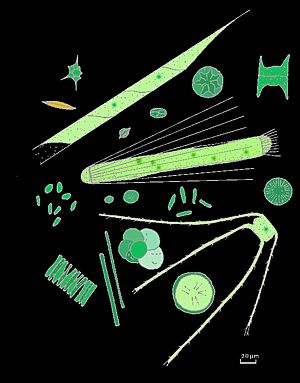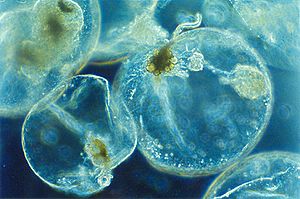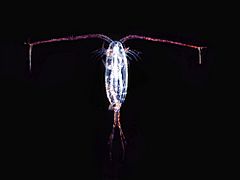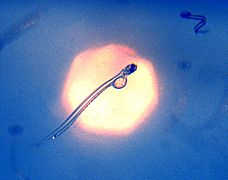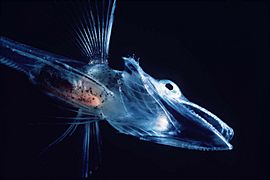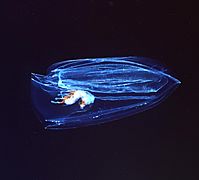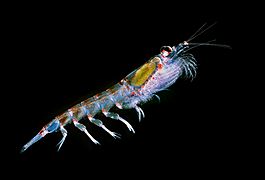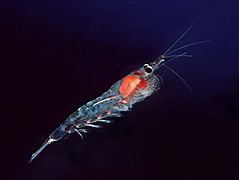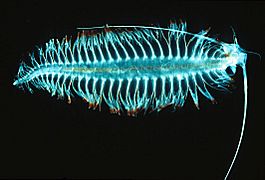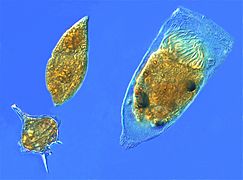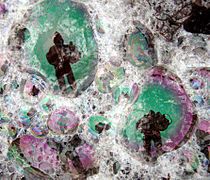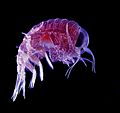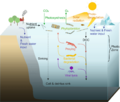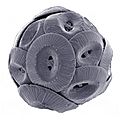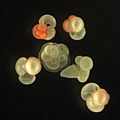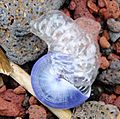Plankton facts for kids
Plankton are tiny living things that float and drift in the top layers of the ocean. They can't swim strongly against the ocean currents, so they just go with the flow! This is different from nekton, which are animals like fish and whales that can swim wherever they want.
There are three main types of plankton:
- Phytoplankton: These are like tiny plants of the ocean. They live near the surface where there's sunlight and make their own food using a process called photosynthesis.
- Some are tiny plant-like cells called diatoms, coccolithophores, and some dinoflagellates.
- Others are a type of bacteria called cyanobacteria.
- Zooplankton: These are like tiny animals. They eat other plankton.
- Mixotrophic Plankton: Some plankton can do both! For example, some dinoflagellates can make their own food using sunlight, but they can also eat other tiny plankton. It's like they have two ways to get energy!
Plankton are super important because they are at the very bottom of the ocean's food chain. This means many other animals in the ocean depend on them for food.
Contents
Why Plankton are Important
Ocean Food Chain
Plankton are the base of the ocean's food chain. This means they are the first link in a long chain that feeds almost all other ocean creatures. Without plankton, many fish and other animals wouldn't have enough to eat, which would affect big industries like fishing.
Helping the Planet: Carbon Cycle
Plankton play a big role in controlling the amount of carbon in the ocean and in our air.
- Phytoplankton take in carbon dioxide from the water to make their food.
- Zooplankton eat phytoplankton, taking in that carbon.
- When plankton die, their bodies sink to the bottom of the ocean. This helps move carbon from the surface down deep into the ocean, keeping it out of the atmosphere. This process is called the biological pump. It's one reason why oceans are the biggest "carbon sinks" on Earth, meaning they store a lot of carbon.
Scientists have thought about trying to grow more plankton to help reduce the amount of carbon dioxide in the air that comes from human activities. They might do this by adding tiny amounts of iron to the ocean, which helps plankton grow. However, this idea might not work on a large scale and could even cause problems, like reducing oxygen in the deep ocean.
Making Oxygen for Us to Breathe
This is a huge one! Just like plants on land, phytoplankton release oxygen into the water when they make their food through photosynthesis. It's estimated that about half of all the oxygen in the world is produced by phytoplankton! The other half comes from plants on land. So, every other breath you take might be thanks to these tiny ocean dwellers!
How Plankton Populations Change
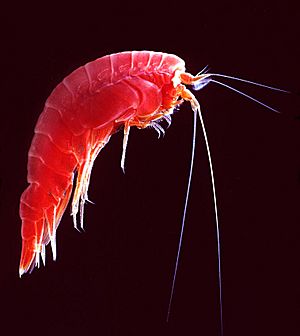
The number of phytoplankton in the ocean depends on how much sunlight they get and how many nutrients are in the water.
- In warm, tropical waters, there's lots of sunlight, but often not enough nutrients.
- In colder, subarctic waters, nutrients are more available, but sunlight can be limited.
Big changes in the environment, like the El Niño weather pattern, can cause the amount of phytoplankton to drop. When this happens, it affects all the animals that eat them, like zooplankton, fish, seabirds, and even marine mammals.
Scientists are also studying how global warming might affect plankton. Changes in ocean temperature and how water layers mix could impact how much food and light plankton get, which would then affect the entire ocean food web.
Even baby fish are considered plankton for a few days after they hatch, until they are strong enough to swim on their own!
- Copepod and larvae
-
A Copepod from Antarctica, a clear, oval-shaped animal with two long antennae.
-
A baby herring swimming, showing its remaining yolk sac and clear body.
-
A siphonophore, showing its "conveyor belt" of growing larvae.
- Other plankton
-
Antarctic krill are tiny shrimp-like creatures, and there are more of them than almost any other single animal species on Earth!
-
Tiny zooplankton, like these two dinoflagellates and a tintinnid ciliate, are major eaters of other plankton.
Importance to Fish
Zooplankton are the first food for almost all baby fish when they start eating after hatching. Fish need lots of zooplankton to be in the right places for their tiny babies to find food, or else the babies might starve. Things like ocean currents or human-made changes (like dams on rivers) can greatly affect zooplankton, which then affects how many baby fish survive and how successful fish breeding is.
People who raise fish in ponds have known for a long time how important plankton are. They often manage their ponds to make sure there's enough plankton for the fish to eat, showing how vital plankton are even in places made by humans.
Images for kids
-
Marine microplankton and mesoplankton This picture shows many different plankton from one scoop of a net, including plant-like cyanobacteria and diatoms, and many types of zooplankton. Some zooplankton live their whole lives as plankton (holoplankton), while others are only plankton for a short time (meroplankton), like fish eggs or crab larvae. -
Plankton (drifting organisms) are different from nekton (swimming organisms), neuston (organisms at the ocean surface), and benthos (organisms on the ocean floor). -
Some beautiful marine diatoms seen under a microscope. They are a very important type of phytoplankton.
-
An amphipod (Hyperia macrocephala).
-
Diatoms have amazing glass shells and produce a lot of the world's oxygen.
-
The detailed silica shells of tiny marine radiolarians can eventually form a type of rock called opal.
-
Coccolithophores have tiny chalk plates called coccoliths, and they helped form famous cliffs like the Cliffs of Dover.
-
A large bloom of planktonic algae (coccolithophores) off the southern coast of England.
-
Foraminiferans have shells made of calcium carbonate and helped create the limestone used in the Great Pyramids.
-
The tiny cyanobacterium Prochlorococcus is a major contributor to the oxygen in our atmosphere.
-
Antarctic krill, which likely have the largest total weight of any single animal species on Earth.
-
Sargassum seaweed floats with ocean currents using air bladders to stay on the surface.
-
A type of large plankton: a Janthina janthina snail with its bubble float, found on a beach in Maui.
See also
 In Spanish: Plancton para niños
In Spanish: Plancton para niños


